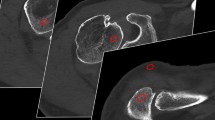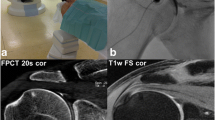Abstract
Objective
To determine in a cadaveric study the lowest achievable radiation dose and optimal tube potential generating diagnostic image quality in multidetector computed tomography (MDCT) arthrography of the shoulder.
Materials and methods
Six shoulders from three human cadavers were scanned using a 256-MDCT system after intra-articular injection of diluted iodinated contrast material. Using six decreasing radiation dose levels (CTDIvol: 20, 15, 10, 8, 6, and 4 mGy) and for each dose level, four decreasing tube potentials (140, 120, 100, and 80 kVp), image noise and contrast-to-noise ratio (CNR) were measured. Two independent and blinded observers assessed the overall diagnostic image quality, subjective amount of noise, and severity of artifacts according to a four-point scale. Influence of those MDCT data acquisition parameters on objective and subjective image quality was analyzed using the Kruskal–Wallis and Wilcoxon signed-rank tests, and pairwise comparisons were performed.
Results
Multidetector CT protocols with radiation doses of 15 mGy or higher, combined with tube potentials of 100 kVp or higher, were equivalent in CNR to the reference 20 mGy–140 kVp protocol (all p ≥ 0.054). Above a CTDIvol of 10 mGy and a tube potential of 120 kVp, all protocols generated diagnostic image quality and subjective noise equivalent to the 20 mGy–140 kVp protocol (all p ≥ 0.22).
Conclusions
Diagnostic image quality in MDCT arthrography of the shoulder can be obtained with a radiation dose of 10 mGy at an optimal tube potential of 120 kVp, corresponding to a reduction of up to 50% compared with standard-dose protocols, and as high as 500% compared with reported protocols in the literature.




Similar content being viewed by others
References
Fritz J, Fishman EK, Small KM, Winalski CS, Horger MS, Corl F, et al. MDCT arthrography of the shoulder with datasets of isotropic resolution: indications, technique, and applications. Am J Roentgenol. 2012;198(3):635–46.
Omoumi P, Bafort A-C, Dubuc J-E, Malghem J, Vande Berg BC, Lecouvet FE. Evaluation of rotator cuff tendon tears: comparison of multidetector CT arthrography and 1.5-T MR arthrography. Radiology. 2012;264(3):812–22.
Acid S, Le Corroller T, Aswad R, Pauly V, Champsaur P. Preoperative imaging of anterior shoulder instability: diagnostic effectiveness of MDCT arthrography and comparison with MR arthrography and arthroscopy. Am J Roentgenol. 2012;198(3):661–7.
Lecouvet FE, Simoni P, Koutaïssoff S, Vande Berg BC, Malghem J, Dubuc J-EE. Multidetector spiral CT arthrography of the shoulder. Clinical applications and limits, with MR arthrography and arthroscopic correlations. Eur J Radiol. 2008;68(1):120–36.
Omoumi P, Rubini A, Dubuc JE, Vande Berg BC, Lecouvet FE. Diagnostic performance of CT-arthrography and 1.5T MR-arthrography for the assessment of glenohumeral joint cartilage: a comparative study with arthroscopic correlation. Eur Radiol. 2015;25(4):961–9.
Omoumi P, Mercier GA, Lecouvet F, Simoni P, Vande Berg BC. CT arthrography, MR arthrography, PET, and scintigraphy in osteoarthritis. Radiol Clin N Am. 2009;47(4):595–615.
Jungmann PM, Agten CA, Pfirrmann CW, Sutter R. Advances in MRI around metal. J Magn Reson Imaging. 2017;46(4):972–91.
Mallo GC, Burton L, Coats-Thomas M, Daniels SD, Sinz NJ, Warner JJP. Assessment of painful total shoulder arthroplasty using computed tomography arthrography. J Shoulder Elbow Surg. 2015;24(10):1507–11. https://doi.org/10.1016/j.jse.2015.06.027.
Biswas D, Bible JE, Bohan M, Simpson AK, Whang PG, Grauer JN. Radiation exposure from musculoskeletal computerized tomographic scans. J Bone Joint Surg Am. 2009;91(8):1882–9.
Gervaise A, Teixeira P, Villani N, Lecocq S, Louis M, Blum A. CT dose optimisation and reduction in osteoarticular disease. Diagn Interv Imaging. 2013;94(4):371–88.
Guggenberger R, Ulbrich EJ, Dietrich TJ, Scholz R, Kaelin P, Köhler C, et al. C-arm flat-panel CT arthrography of the shoulder: radiation dose considerations and preliminary data on diagnostic performance. Eur Radiol. 2017;27(2):454–63.
Sinnott B, Ron E, Schneider AB. Exposing the thyroid to radiation: a review of its current extent, risks, and implications. Endocr Rev. 2010;31(5):756–73.
Mazonakis M, Tzedakis A, Damilakis J, Gourtsoyiannis N. Thyroid dose from common head and neck CT examinations in children: is there an excess risk for thyroid cancer induction? Eur Radiol. 2007;17(5):1352–7.
Waldt S, Metz S, Burkart A, Mueller D, Bruegel M, Rummeny EJ, et al. Variants of the superior labrum and labro-bicipital complex: a comparative study of shoulder specimens using MR arthrography, multi-slice CT arthrography and anatomical dissection. Eur Radiol. 2006;16(2):451–8.
De Maeseneer M, Boulet C, Pouliart N, Kichouh M, Buls N, Verhelle F, et al. Assessment of the long head of the biceps tendon of the shoulder with 3T magnetic resonance arthrography and CT arthrography. Eur J Radiol. 2012;81(5):934–9. https://doi.org/10.1016/j.ejrad.2011.01.121.
Bongartz G, Golding SJ, Jurik AG, Leonardi M, van Persijn van Meerten E, Geleijns J, et al. European guidelines on quality criteria for computed tomography. March 2004. Available from: http://www.drs.dk/guidelines/ct/quality/mainindex.htm.
FOPH Swiss Federal Office of Public Health. Notice R-06-06. Ref R-06-06df. Established 01.04.2010.
Omoumi P, Becce F, Ott JG, Racine D, Verdun FR. Optimization of radiation dose and image quality in musculoskeletal CT: emphasis on iterative reconstruction techniques I. Semin Musculoskelet Radiol. 2015;19(5):415–21.
Omoumi P, Verdun FR, Becce F. Optimization of radiation dose and image quality in musculoskeletal CT: emphasis on iterative reconstruction techniques II. Semin Musculoskelet Radiol. 2015;19(5):422–30.
Omoumi P, Becce F, Racine D, Ott JG, Andreisek G, Verdun FR. Dual-energy CT: basic principles, technical approaches, and applications in musculoskeletal imaging I. Semin Musculoskelet Radiol. 2015;19(5):431–7.
Radiological Society of North America. RadLex: a lexicon for uniform indexing and retrieval of radiology information resources [Internet]. March 2018. Available from: http://radlex.org/.
Landis JR, Koch GG. The measurement of observer agreement for categorical data. Biometrics. 1977;33(1):159–74.
Racine D, Viry A, Becce F, Schmidt S, Ba A, Bochud FO, et al. Objective comparison of high-contrast spatial resolution and low-contrast detectability for various clinical protocols on multiple CT scanners. Med Phys. 2017;44(9):e153–63.
Simoni P, Leyder PP, Albert A, Malchair F, Maréchal C, Scarciolla L, et al. Optimization of computed tomography (CT) arthrography of hip for the visualization of cartilage: an in vitro study. Skeletal Radiol. 2014;43(2):169–78.
Roth TD, Buckwalter KA, Choplin RH. Musculoskeletal computed tomography: current technology and clinical applications. Semin Roentgenol. 2013;48(2):126–39. https://doi.org/10.1053/j.ro.2012.11.009.
Gurung J, Khan MF, Maataoui A, Herzog C, Bux R, Bratzke H, et al. Multislice CT of the pelvis: dose reduction with regard to image quality using 16-row CT. Eur Radiol. 2005;15(9):1898–905.
Subhas N, Freire M, Primak AN, Polster JM, Recht MP, Davros WJ, et al. CT arthrography: in vitro evaluation of single and dual energy for optimization of technique. Skeletal Radiol. 2010;39(10):1025–31.
Ahn SJ, Hong SH, Chai JW, Choi J-YY, Yoo HJ, Kim SH, et al. Comparison of image quality of shoulder CT arthrography conducted using 120 kVp and 140 kVp protocols. Korean J Radiol. 2014;15(6):739–45.
Kaza RK, Platt JF, Goodsitt MM, Al-Hawary MM, Maturen KE, Wasnik AP, et al. Emerging techniques for dose optimization in abdominal CT. Radiographics. 2014;34(1):4–17.
Von Falck C, Galanski M, Shin H. Informatics in radiology: sliding-thin-slab averaging for improved depiction of low-contrast lesions with radiation dose savings at thin-section CT. Radiographics. 2010;30:317–26. https://doi.org/10.1148/rg.302096007.
Becce F, Ben Salah Y, Verdun FR, Vande Berg BC, Lecouvet FE, Meuli R, et al. Computed tomography of the cervical spine: comparison of image quality between a standard-dose and a low-dose protocol using filtered back-projection and iterative reconstruction. Skeletal Radiol. 2013;42(7):937–45.
Omoumi P, Verdun FR, Ben Salah Y, Vande Berg BC, Lecouvet FE, Malghem J, et al. Low-dose multidetector computed tomography of the cervical spine: optimization of iterative reconstruction strength levels. Acta Radiol. 2014;55(3):335–44.
Geyer LL, Körner M, Hempel R, Deak Z, Mueck FG, Linsenmaier U, et al. Evaluation of a dedicated MDCT protocol using iterative image reconstruction after cervical spine trauma. Clin Radiol. 2013;68(7):391–6.
Tobalem F, Dugert E, Verdun FR, Dunet V, Ott JG, Rudiger HA, et al. MDCT arthrography of the hip: value of the adaptive statistical iterative reconstruction technique and potential for radiation dose reduction. AJR Am J Roentgenol. 2014;203(6):W665–73.
Acknowledgments
We would like to thank the Anatomy Lab of the Cliniques Universitaires Saint-Luc, Université Catholique de Louvain, for providing us with the cadavers.
Author information
Authors and Affiliations
Corresponding author
Ethics declarations
Conflicts of interest
None.
Additional information
Publisher’s note
Springer Nature remains neutral with regard to jurisdictional claims in published maps and institutional affiliations.
Rights and permissions
About this article
Cite this article
Aguet, J., Becce, F., Dunet, V. et al. Optimizing radiation dose parameters in MDCT arthrography of the shoulder: illustration of basic concepts in a cadaveric study. Skeletal Radiol 48, 1261–1268 (2019). https://doi.org/10.1007/s00256-019-3150-6
Received:
Revised:
Accepted:
Published:
Issue Date:
DOI: https://doi.org/10.1007/s00256-019-3150-6




